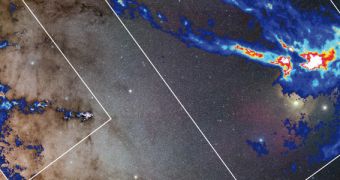A team of experts from the Max Planck Institute for Astronomy (MPIA) in Heidelberg, Germany, led by astrophysicist Jouni Kainulainen, proposes in a new study a novel mechanism to explain stellar formation that is simpler and more elegant than other models available today. The new results are based on an analysis of how matter is distributed through cosmic structures called stellar nurseries.
These nurseries are very large nebulae that contain massive amounts of cosmic gas and dust, the two main ingredients needed to form protostars. Astronomers figured out long ago that new stars are born from clouds inside these nebulae, which collapse under their own weight. The extreme friction that occurs during this implosion raises temperatures to millions of degrees, triggering nuclear fusion.
Understanding how new stars form and the processes that lead to this phenomenon is very important for explaining the origins, structure, history, and evolution of galaxies. Additionally, these studies could help explain how and why the supermassive black holes at the cores of all galaxies appeared and evolved so early on in the history of the Universe.
In the new study, the MPIA team decided to address a lack of data on matter distribution inside stellar nurseries by creating a series of dust-extinction maps. These are datasets that centralize dust scattering and light absorbing patterns inside the giant gas and dust clouds. Basically, the team analyzed how light hitting these large clouds dimmed on contact.
Over time, the German group analyzed how light from thousands of stars was dimmed upon contact with 16 molecular clouds, all located within 850 light-years of our planet. This enabled the experts to recreate the inner structure of the molecular clouds in the nebulae in 3D, yielding unprecedented amounts of data on how new stars are born, Space reports.
We devised “a very concrete recipe for how new stars are born in the interstellar gas clouds. And the ingredients of this recipe are simple to understand – only those regions in the clouds in which density is higher than about 5,000 molecules per cubic centimeter produce stars, and about a tenth of the gas in these regions collapses into the new stars,” says Kainulainen, the lead author of the new study.
“We have given astronomers a new tool to estimate the rates at which molecular clouds form stars, without even seeing the new stars in the clouds. I quote my collaborator Thomas Henning – ‘Show us your image of a cloud, and we can tell you how much it forms stars right now’,” he goes on to say.
One of the most significant implications of the new study is that radio telescopes such as the Atacama Large Millimeter/submillimeter Array (ALMA) could from now on be used to map the distribution of material inside stellar nurseries, thus reconstructing their inner structure and revealing their star-forming potential.
Kainulainen concludes by saying that these results should only be used to analyze stellar formation in the Local Group of galaxies and in the Milky Way, since protostar synthesis conditions somewhere else, or in the early Universe, may have been different.

 14 DAY TRIAL //
14 DAY TRIAL //